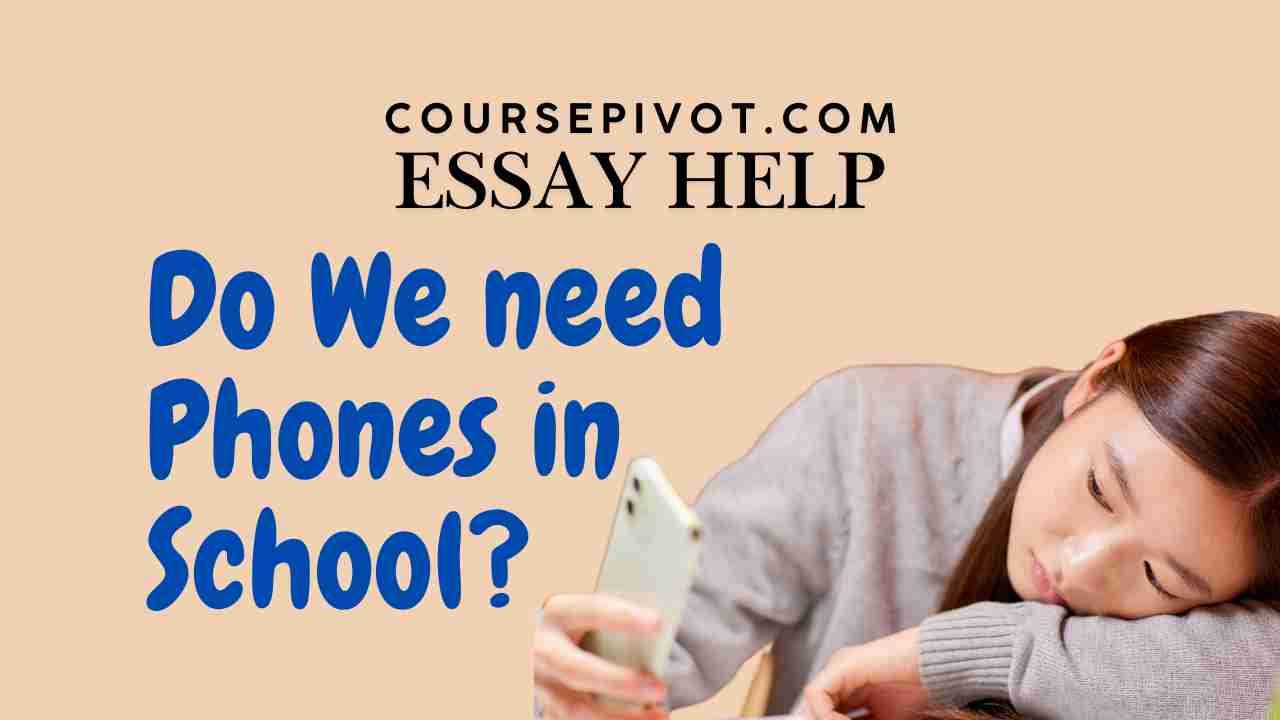100 Good Reasons why Students Should have Phones in School

The question as to whether schools should allow or ban cell phones has been debated much for years now. Many students believe they should be able to take phones to class while others consider banning phones in school. To understand the most feasible argument, we need to analyze all the reasons why we should allow uniforms, or rather why schools shouldn’t ban phones.
Before I tell you why schools should allow phones in school, you can read our other articles on paying students for good grades, school days being shorter, or banning school uniforms in school.
Many schools are not racing to ban student phones in school. These are the 100 most common and reasonable excuses to allow phones in school today.
Top 100 good reasons why schools should allow phones
There are many reasons why schools shouldn’t ban phones in school. I will provide not 3, 5, 10, 20 or 50 reasons; Instead, I will give you hundred best reasons why students should carry phones in school. I will be using facts and evidence based arguments here, not baseless opinions.
1. Emergency Communication and Safety:
Phones are essential for immediate contact in emergencies, ensuring student safety.
- 1️⃣. Immediate contact with parents in emergencies.
- 2️⃣. Ability to call 911 for urgent assistance.
- 3️⃣. Quick notification of school lockdowns or evacuations.
- 4️⃣. Location tracking for student safety during field trips or off-campus activities.
- 5️⃣. Instant reporting of suspicious activity or bullying incidents.
- 6️⃣. Communication during unexpected school closures or weather events.
- 7️⃣. Medical emergency contact and information access.
- 8️⃣. Ability to contact a trusted adult when feeling unsafe.
- 9️⃣. Facilitating communication during natural disasters.
- 1️⃣0️⃣. Rapid dissemination of critical safety information.
2. Educational Tool and Resource:
Phones can be powerful learning tools, offering access to information and educational applications.
- 1️⃣1️⃣. Access to online dictionaries and translation tools.
- 1️⃣2️⃣. Research and fact-checking during class discussions.
- 1️⃣3️⃣. Use of educational apps for math, science, and language learning.
- 1️⃣4️⃣. Access to digital textbooks and educational resources.
- 1️⃣5️⃣. Note-taking and recording lectures for later review.
- 1️⃣6️⃣. Access to online libraries and databases.
- 1️⃣7️⃣. Collaboration on group projects through shared documents and messaging.
- 1️⃣8️⃣. Quick access to calculators and scientific tools.
- 1️⃣9️⃣. Language learning through apps and online resources.
- 2️⃣0️⃣. Access to podcasts and educational videos.
3. Organization and Time Management:
Phones can help students stay organized and manage their time effectively.
- 2️⃣1️⃣. Use of digital calendars and reminders for assignments.
- 2️⃣2️⃣. Setting alarms for study sessions and deadlines.
- 2️⃣3️⃣. Access to digital planners and to-do lists.
- 2️⃣4️⃣. Time tracking for projects and study habits.
- 2️⃣5️⃣. Use of note-taking apps for organizing class materials.
- 2️⃣6️⃣. Quick access to school schedules and event calendars.
- 2️⃣7️⃣. Ability to set timers for study breaks.
- 2️⃣8️⃣. Use of digital flashcards for reviewing material.
- 2️⃣9️⃣. Easy access to contact information for teachers and classmates.
- 3️⃣0️⃣. Use of organizational apps for managing schoolwork.
4. Communication and Collaboration:
Phones facilitate communication and collaboration among students and teachers.
- 3️⃣1️⃣. Instant communication with teachers for questions or clarifications.
- 3️⃣2️⃣. Collaboration on group projects through messaging apps.
- 3️⃣3️⃣. Easy communication with classmates for study groups.
- 3️⃣4️⃣. Quick sharing of notes and resources.
- 3️⃣5️⃣. Facilitating communication during extracurricular activities.
- 3️⃣6️⃣. Ability to contact teachers during after-school hours for assistance.
- 3️⃣7️⃣. Communication with parents for schedule changes or pick-up arrangements.
- 3️⃣8️⃣. Quick coordination for school events and activities.
- 3️⃣9️⃣. Facilitating communication for students with special needs.
- 4️⃣0️⃣. Easy communication with school counselors or support staff.
5. Developing Digital Literacy and Responsibility:
Phones provide opportunities for students to develop essential digital skills.
- 4️⃣1️⃣. Learning responsible use of technology.
- 4️⃣2️⃣. Developing digital citizenship skills.
- 4️⃣3️⃣. Understanding online safety and privacy.
- 4️⃣4️⃣. Learning to evaluate online information and sources.
- 4️⃣5️⃣. Developing skills in using digital communication tools.
- 4️⃣6️⃣. Learning to manage digital distractions.
- 4️⃣7️⃣. Understanding the impact of social media and online behavior.
- 4️⃣8️⃣. Developing skills in using educational apps and online resources.
- 4️⃣9️⃣. Learning to use digital tools for academic research.
- 5️⃣0️⃣. Preparing students for a technologically driven world.
6. Accessibility and Inclusivity:
Phones can provide accessibility tools for students with disabilities.
- 5️⃣1️⃣. Use of text-to-speech and speech-to-text features.
- 5️⃣2️⃣. Access to accessibility apps for students with visual or hearing impairments.
- 5️⃣3️⃣. Communication tools for students with speech difficulties.
- 5️⃣4️⃣. Use of magnification tools for students with visual impairments.
- 5️⃣5️⃣. Access to assistive technology apps for students with learning disabilities.
- 5️⃣6️⃣. Facilitating communication for students with social anxiety.
- 5️⃣7️⃣. Use of translation apps for students with language barriers.
- 5️⃣8️⃣. Access to digital resources for students with physical disabilities.
- 5️⃣9️⃣. Providing personalized learning tools for diverse learners.
- 6️⃣0️⃣. Creating a more inclusive learning environment.

7. Personal Development and Creativity:
Phones can be tools for personal expression and creative endeavors.
- 6️⃣1️⃣. Photography and videography for creative projects.
- 6️⃣2️⃣. Access to music and audio editing apps.
- 6️⃣3️⃣. Digital art and design tools.
- 6️⃣4️⃣. Creative writing and storytelling apps.
- 6️⃣5️⃣. Access to online portfolios and creative platforms.
- 6️⃣6️⃣. Recording and sharing student performances.
- 6️⃣7️⃣. Documenting school events and memories.
- 6️⃣8️⃣. Creating digital presentations and multimedia projects.
- 6️⃣9️⃣. Exploring personal interests and hobbies.
- 7️⃣0️⃣. Fostering digital creativity and innovation.
8. Real-World Relevance and Preparation:
Phones prepare students for a world where technology is ubiquitous.
- 7️⃣1️⃣. Integrating technology into the learning environment.
- 7️⃣2️⃣. Developing skills in using digital tools for professional communication.
- 7️⃣3️⃣. Preparing students for digital workplaces.
- 7️⃣4️⃣. Fostering adaptability to technological advancements.
- 7️⃣5️⃣. Learning to use digital tools for research and information management.
- 7️⃣6️⃣. Developing skills in using digital collaboration tools.
- 7️⃣7️⃣. Understanding the role of technology in modern society.
- 7️⃣8️⃣. Preparing students for online learning environments.
- 7️⃣9️⃣. Developing skills in using digital platforms for presentations.
- 8️⃣0️⃣. Integrating technology into project-based learning.
9. Reducing Reliance on School Resources:
Phones can alleviate the burden on school resources and infrastructure.
- 8️⃣1️⃣. Reducing the need for school-provided computers and tablets.
- 8️⃣2️⃣. Minimizing the cost of printing and paper.
- 8️⃣3️⃣. Reducing reliance on school phone lines.
- 8️⃣4️⃣. Alleviating the burden on school IT infrastructure.
- 8️⃣5️⃣. Reducing the need for physical textbooks and materials.
- 8️⃣6️⃣. Minimizing the need for school-provided calculators and tools.
- 8️⃣7️⃣. Reducing the cost of maintaining school computer labs.
- 8️⃣8️⃣. Alleviating the burden on school libraries and resource centers.
- 8️⃣9️⃣. Providing students with their own personalized learning tools.
- 9️⃣0️⃣. Reducing the need for school-provided digital devices.
10. Fostering Independence and Responsibility:
Phones can help students develop independence and responsibility.
- 9️⃣1️⃣. Learning to manage personal devices responsibly.
- 9️⃣2️⃣. Developing self-discipline in using technology.
- 9️⃣3. Learning to balance screen time and other activities.
- 9️⃣4️⃣. Developing skills in managing digital distractions.
- 9️⃣5️⃣. Learning to use technology for academic purposes.
- 9️⃣6️⃣. Developing skills in online communication and collaboration.
- 9️⃣7️⃣. Learning to use digital tools for personal organization.
- 9️⃣8️⃣. Fostering a sense of ownership over learning tools.
- 9️⃣9️⃣. Encouraging students to take responsibility for their own learning.
- 1️⃣0️⃣0️⃣. Building trust and autonomy in students’ ability to use technology wisely.
My Thoughts
Schools should allow students to carry phones because they serve as vital tools for emergency communication and safety, enabling immediate contact with parents and emergency services. Beyond safety, phones offer a wealth of educational resources, facilitating access to online dictionaries, educational apps, and digital textbooks.
Read our blog on why teaching is the best profession.
Student phones aid in organization and time management through digital calendars and reminders, and foster communication and collaboration among students and teachers. Integrating phones into the classroom helps develop essential digital literacy and responsibility, while also providing accessibility tools for students with disabilities.
Phones in schools encourage personal development and creativity, prepare students for a technologically driven world, reduce reliance on school resources, and foster independence and responsibility. In essence, phones are more than distractions; they are multifaceted tools that can enhance learning and safety when used appropriately.
- Remember, you can hire someone on Coursepivot.com to do your assignment for you online. Coursepivot is the leading assignment help service for students.
Pay someone to do my Assignment for me
Coursepivot is the best custom assignment writing service
Cite this article
You can copy and paste your preferred citation format below.
Martin, L. & Arquette, E.. (2025, April 3). 100 Good Reasons why Students Should have Phones in School. Coursepivot.com. https://coursepivot.com/blog/why-students-should-have-phones-in-school/



